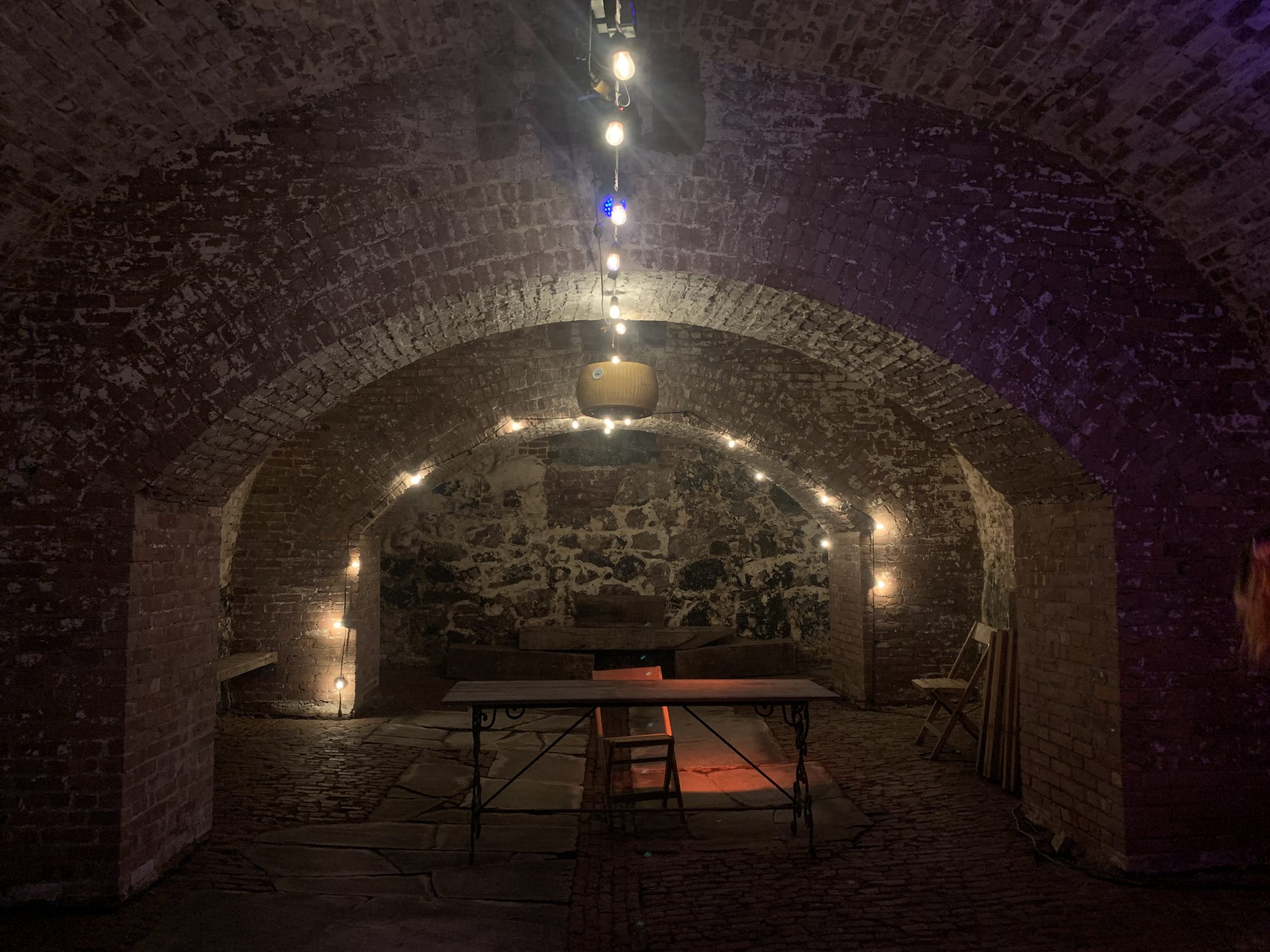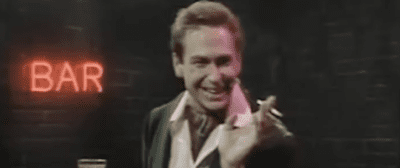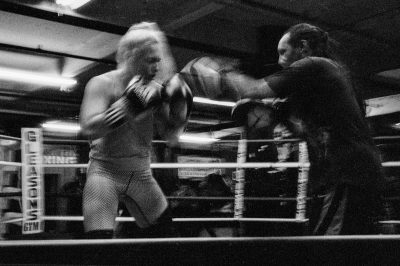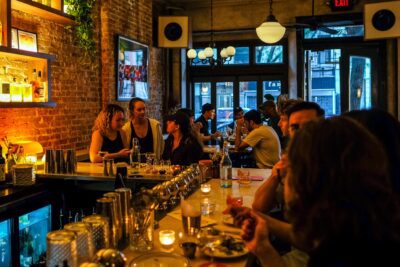Photo by Benton Brown
Meet the 16-year-old banjoist who recorded an album in a Crown Heights cave
Nora Brown's 'Sidetrack My Engine' was taped on analog equipment in the fermentation caves under her parents' cheese shop
Nora Brown is accustomed to friends and strangers not quite grasping her extracurricular activities.
“When people hear that I play the banjo, especially people in my school, will be like, ‘what?” she says. “The interest makes no sense for some people. It makes total sense that they would have the reaction, but it’s kind of hard to explain in one sitting or, if someone finds out about that and they ask a question. You’re kind of like, ‘Where do I start?’”
Well. Brown, who is 16, started with the ukulele, taking lessons with a local teacher who specialized in old time music, eventually transitioning to the instrument that captured her attention the most: the banjo. Now a junior at the Frank Sinatra School of the Arts in Astoria, Queens, Brown is a rising star in the world of bluegrass music. Her first album, “Cinnamon Tree,” released when she was 13, debuted in the top ten on the Billboard Bluegrass Chart and at the top of this year, she appeared on NPR’s Tiny Desk series.
For her next record, “Sidetrack My Engine,” released September 24, Brown utilized some home recording tools like many musicians during the pandemic. Unlike many musicians during the pandemic, though, her home is a cheese factory with 1850s fermenting tunnels beneath it: Brown’s parents own and operate Crown Finish Caves, a cheese aging facility located in the former lagering tunnels of the Nassau Brewery in Crown Heights.
Using an (extremely heavy) Ampex tape machine and vintage RCA ribbon mics, “Sidetrack My Engine,” which includes newly arranged versions of songs that Brown learned through the continued tradition of visiting elder musicians, from old records and from field recordings in archival collections, was recorded to tape in the underground caves in August 2020.
Brooklyn Magazine caught up with Brown, who performed the new songs Saturday at the Jalopy Theatre—where Red Hook gives way to the Columbia Street waterfront district— to talk about the banjo, the traditions of Appalachian music and the community she’s found in Brooklyn.
This interview has been condensed for clarity and length.
Tell me about the first time the sound of a banjo struck you.
I can’t pinpoint an exact time for that. But I did start playing ukulele when I was six and I started learning from this guy named Shlomo Pesco, who was an incredible musician, historian, and he lived in Brooklyn nearby-ish. He just solely taught old time music and folk songs and stuff like that, especially to kids. And so that’s what I began learning, without thinking it was something unique or special, to be learning this style of music here, you know? Where, rather, it is kind of unusual.
Was there anything about the banjo that was more attractive to you than, say, the piano or the regular guitar?
I feel more comfortable on the banjo. And it feels like there are more possibilities. But also, the banjo always seemed very cool to me. And it’s kind of a unique instrument compared to other stringed instruments, where it has that dropped fifth string that is used as a drone string, which is not very common among just classical instruments. It has a very unique sound that I was drawn to.
Obviously, New York City isn’t known to the mainstream to be a hotbed of banjo music, but it does sort of seem like there’s a sturdy community here of bluegrass musicians. Is that accurate?
Yeah, there’s definitely a strong old time folk situation. It definitely revolves a bit around the Jalopy Theatre, in Red Hook. It’s an awesome venue that older musicians traveling through, definitely stop and play there. The more people that play or that come here and know how to play, the more it attracts, because it’s a cool city on its own and you can be close to so many musicians. A lot of the heart of this music is playing with other people.
Let’s talk a little about your new album—it was recorded in an underground cave using vintage equipment? How did you come to that decision?
Well, my parents are in the cheese business, and there are these old lagering tunnels that are underneath the house. So my parents came here, they were like, ‘what are we going to use these tunnels for? They’re so cool. And there’s so much potential. Something really cool could happen there.’ There are a lot of fermented things that like tunnels, cheese is one of them. Before [the] pandemic, we started to do a concert series in some of the empty caves that aren’t used for cheese. And they were called “Cave Music.” Sometimes we’d have musicians come through and play and it was very fun, very cool. So we already knew that it sounded very cool in there and it’s a nice space to record, it’s so empty. It ended up being a little bit tricky, because we were using this old equipment, things like reel-to-reel tape machines and vintage RCA ribbon mics. That kind of provided an extra layer of difficulty to the session, because that equipment is best used in a more controlled environment and [in] the caves, there’s so much space for sound to bounce around.

The songs on this new album are ones that you’ve either learned through archival recordings of traditional songs or you’ve “inherited” them from older banjo players. Why do you think it’s important to keep passing this music down?
As much as the music is a part of this tradition, it’s also the building of relationships through passing down music and sharing music. Spending time with old musicians and learning directly from the source is very important to preserving the authenticity of music, because it’s not just about learning things exactly how they sound on a recording, it’s also about having a connection to it.
What do your friends think of your music?
I go to this art school now for high school, so it’s pretty normal to do something artistic like, seriously. For middle school and elementary school, I went to Community Roots, which is a charter school in Fort Greene. Great school, definitely a different crowd.
When people think of banjo players or bluegrass music, they often will have a stereotypical, almost cartoonish, image in their head. What do you wish people knew about the banjo and this style of playing?
It’s super whitewashed. I can bet that if you ask any random person on the street ‘who invented the banjo?’ or ‘who plays the banjo?’ it’s gonna be a white dude in their head. So one important thing that I would like people to know is about the African history around the banjo. When people think of old time and bluegrass music, it’s so American, true American music, and it’s like, that’s just not really the whole picture, as is with almost everything. It’s not American, it’s African American. It’s an African instrument, but in reality, what we know today is African American because people recalled the instrument that they had in the home and kind of recreated it with the materials that they had here.
And women in bluegrass music were a big part of that history, right?
Yeah, and, interestingly enough, when the banjo was being popularized, the banjo was actually advertised as a woman’s instrument, like a womanly instrument, something you’d play in the parlor. So there were many, many women banjo players in the early recording phase, just they weren’t getting signed to things and weren’t looked at.
When you’re not working on your music, what do you like to do for fun in Brooklyn?
I like to go thrifting with my friends, I recently had a pretty good haul. I like to read, I like to draw sometimes. I have injured knees right now from a hiking trip earlier this summer, but I also skateboard. We’re close to Prospect Park, so it’s always fun to hang out there.
When you consider your future career, what does that look like?
I actually don’t know if I want to have a career in music. But I do know I want to continue playing music. I always want to play, but I think I probably would want a career in environmental sciences, maybe, or something related to climate activism.
You might also like 


























